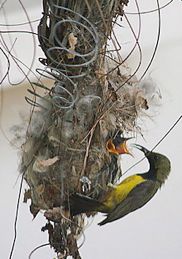“What caused two nesting failures on the same plant?” was posted earlier. Lam Chun See then thought that the pair of Olive-backed Sunbirds (Cinnyris jugularis) that had been busy constructing their nest attached to his bromeliad plant abandoned it after completion. He realised this was not so when, on 16th July 2007, he found out that the female had discreetly returned regularly, to lay her eggs and to incubate them.
On 27th July his children reported that the eggs had hatched and there were two chicks in the nest (top left). By 4th August the chicks were very active, calling for food whenever any of the adults were around (top right). The images below show the male (below left) as well as the female (below right) helping to feed the hungry chicks. Note the extremely wide gape of the hungry chicks as they eagerly waited to be fed.
As Chun See wrote in his blog: “I noticed an interesting behaviour. After they have found some food, they would not fly directly to the nest. Maybe, they spotted me lurking behind the curtains with my camera. So what they did was to first fly to a nearby branch and check out the situation for about 10 to 20 seconds. When they were sure that the coast was clear, then they would fly to the nest to feed the babies.”
As with many birds, soon after feeding the adult will remove the chick’s wastes which are excreted enclosed inside a neat mucilaginous faecal sac. This is picked up from the chick’s posterior end and deposited some distance away from the nest. Why? You need to check out (1, 2) to find out. In the images above, the one on the left shows the female adult poking her head into the nest chamber to remove the faecal sac, shown on the right.
On 11th August the older chick fledged, flying into the neighbour’s house. The parents were around making lots of noise. When Chun See checked on the nest, he found the other chick inside. But his presence caused the second chick to also fledge. So the nest is now empty.
Lam Chun See
Singapore
August 2007










